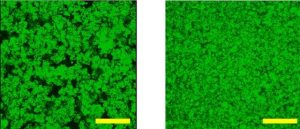 PIB Delhi – Scientists have developed a novel experimental framework in fluid dynamics to describe deformation in disordered soft solids formed by mixing solid grains at significant proportions in a simple liquid which can help in developing early warning systems to minimize damage due to catastrophic events like landslides/earthquakes. Granular systems exist all around us — in material processing industries that deal with dry grains and slurries flowing through pipelines over large distances and in catastrophic natural phenomena like earthquakes and landslides. These systems are comprised of grains that are essentially similar to grains of rice. Rice grains can be packed better into a container by shaking the container. The forces coming from shaking make the grains gradually more compact until it reaches a critical degree of compaction.
PIB Delhi – Scientists have developed a novel experimental framework in fluid dynamics to describe deformation in disordered soft solids formed by mixing solid grains at significant proportions in a simple liquid which can help in developing early warning systems to minimize damage due to catastrophic events like landslides/earthquakes. Granular systems exist all around us — in material processing industries that deal with dry grains and slurries flowing through pipelines over large distances and in catastrophic natural phenomena like earthquakes and landslides. These systems are comprised of grains that are essentially similar to grains of rice. Rice grains can be packed better into a container by shaking the container. The forces coming from shaking make the grains gradually more compact until it reaches a critical degree of compaction.
Interestingly, such critical compaction encodes the information about the interactions between the grains coming from inter-particle friction, the shape of the particles, sticky-ness, and so on. Although it is well known from previous studies that the complex flow behaviour in dense suspensions is determined by the inter-particle interactions, a quantitative correlation between the flow behaviour and the inter-particle interactions remains missing. A group of researchers from Raman Research Institute, an autonomous institute of the Department of Science and Technology has proposed a novel experimental framework, combining the concept of fluid dynamics and how grains become gradually immobile at high enough compaction (called the jamming transition), to describe the deformation and failure in disordered soft solids formed by dispersing granular particles in simple fluids.
They have established a quantitative correlation between the flow behaviour and the inter-particle interactions and validated it over a wide parameter range. The researchers have used the concept motivated by the compaction of rice grains to understand dense suspensions and have further confirmed the idea by tuning the inter-particle interactions using surfactants (which are essentially soap molecules). Using a combination of experimental techniques like shear-rheology which essentially measures the force-deformation response of materials, particle settling to determine the degree of compaction, and boundary imaging to observe the nature of flow in the system, they establish such a correlation in a quantitative manner in a paper recently published in the journal Communications Physics Journal of Nature publishing group.





